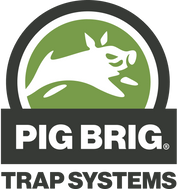Feral Hogs and Disease: What Landowners Should Know

When most people think of disease, they think of livestock, wildlife, or food safety. But feral hogs can play a role in spreading illnesses that affect all three. They are not just tough on crops and soil; they can also impact animal health and the environment. Understanding how and why this happens is the first step toward managing it.
How Hogs Spread Disease
Feral hogs are highly mobile and often interact with the land in ways that spread pathogens. When they root through soil or wallow in shared water sources, they can introduce bacteria and viruses to new areas. Researchers have identified more than 60 diseases that feral hogs can carry, with about 20 of those capable of affecting people. While not every hog carries a disease, their behaviors make them effective at moving pathogens across property lines and watersheds.
Below are a few key examples of diseases linked to feral hog activity:
African Swine Fever (ASF)
A highly contagious viral disease that affects domestic pigs and feral hogs, though not humans. It spreads through contact with infected animals, carcasses, feed, or ticks, posing a serious risk to domestic swine herds.
Chronic Wasting Disease (CWD)
A prion disease that affects deer and elk, not hogs directly. However, hogs can disturb infected carcasses or soil, potentially moving contaminated material across the landscape and complicating control efforts.
Screwworm (Cochliomyia hominivorax)
A parasitic fly larvae that infest livestock, wildlife, and sometimes feral hogs, feeding on living tissue from open wounds. Hogs can act as hosts and carriers, spreading larvae to new areas as they move through infested habitats. Screwworms were eradicated from the United States in 1966, but recent reemergence in Mexico increases the risk of reintroduction.
Brucella (Brucellosis)
A bacterial disease that affects feral hogs, livestock (especially cattle and swine), and humans. It spreads through contact with infected fluids, tissues, or contaminated soil and water.
Pseudorabies (Aujeszky’s Disease)
A viral disease that infects feral hogs, domestic pigs, and other mammals such as cattle and dogs, though it does not affect humans. It spreads through saliva, nasal discharge, or contaminated feed and equipment. Once infected, feral hogs carry it for life and can shed it when stressed.
Anthrax
A bacterial disease caused by Bacillus anthracis that affects hogs, livestock, wildlife, and humans. Feral hogs can expose or ingest spores while rooting and spread contamination through their movement or carcasses.
Leptospirosis
A bacterial infection that targets hogs, livestock, dogs, and humans, often affecting the kidneys and liver. It spreads when hogs shed bacteria in urine that contaminates soil or water sources.
Salmonella
A bacterial infection that affects hogs, livestock, wildlife, and humans, often causing gastrointestinal illness. It spreads through feces, contaminating feed, water, and soil near shared feeding or watering areas.
E. coli
Certain strains of Escherichia coli are bacterial pathogens that affect livestock, wildlife, and humans. Feral hogs contribute to the spread by defecating in fields, pastures, or water sources, where bacteria can contaminate crops or infect other animals.
Why This Matters
When disease enters feral hog populations, it’s unlikely to stay there. Hogs can spread disease to livestock, so farmers and ranchers can experience reduced productivity, lower reproduction rates, higher veterinary costs, and in some cases, losses to their herds.
They can also impact wildlife and water quality. Contaminated soil and water can stress native species and upset natural balance. Fewer hogs mean fewer opportunities for disease, so reducing hog populations is a key step in minimizing these risks.
Steps You Can Take
If you trap or handle feral hogs, a few simple precautions can make a big difference.
- Wear gloves, safety glasses, and a mask when handling hogs or cleaning equipment.
- Avoid direct contact with blood or fluids when handling carcasses or raw meat.
- Clean your equipment and any vehicles used during the dispatch or disposal process with a 2-5% bleach and water solution to reduce the risk of disease spread. Keep in mind that cleaning alone may not eliminate all pathogens, so protective gear should always be used.
- If processing meat, check for signs of illness, such as lesions or abnormal conditions, before bringing it home, and cook to an internal temperature of 160°F for 5 minutes before eating.
Working Toward Healthy Land
Healthy land depends on balance. Disease disrupts that balance by affecting everything from pasture productivity to native plants and wildlife. Reducing feral hog populations helps maintain that balance, supporting farmers, wildlife managers, and ecosystems alike.
At Pig Brig, we’re proud to be part of that work, providing trap systems engineered for performance, safety, and efficiency. The Pig Brig® Trap System uses a passive net design that works with hogs’ natural behavior to effectively capture entire sounders. Whole-sounder removal is one of the most effective ways to break breeding cycles, reduce populations, and slow the spread of disease. Trapping remains one of the most practical tools for feral hog management, and we’re here to help landowners get it done.
For more information on disease prevention and reporting, visit the U.S. Department of Agriculture website.
The fight against disease starts where the tracks begin. Let’s stay ready for it.
 FINANCING AVAILABLE
FINANCING AVAILABLE


